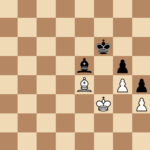 In most chess games when the queens are off the board, you have found yourself in the endgame.
In most chess games when the queens are off the board, you have found yourself in the endgame.
The endgame can be very unpredictable and you really want to know what you’re doing before you get to this point in the game because every move counts.
Your main focus should be to get the right pieces in the right position heading into the endgame, and looking for the quickest way to checkmate your opponent.
If your pawns are not in the right place, or you have too many pawn islands, you may find yourself in a bad position and unable to recover.
You’ll also want to consider whether you keep your knights or bishops when trading before the endgame. In most cases, it’s better to have both bishops rather than knights, but not all the time.
In an open endgame when there are not that many pieces on the board, you’ll want bishops and rooks. In a closed endgame, it is generally better to have knights because they can hop around pawns that are gridlocked.
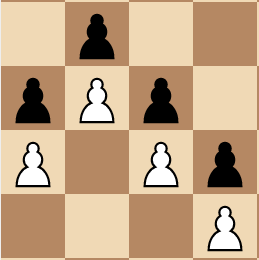
I put together a few endgame principles that believe are essential to understand your journey to endgame mastery.
- Centralize your King
- Attempt to Force Zugzwang
- Obtain Opposition
- Avoid Stalemate When You’re Ahead
- Create a Passed Pawn
- Get Your Rooks Behind Passed Pawns
- Exchange When Ahead
- Isolate the Opponent’s King
Table of Contents
1. Centralize your King
If the queens are off the board, the best thing you want to do first is centralize your king. Even when there are a lot of minor pieces on the board.
In the opening, the king is the main focal point of attack but in the endgame the king is very powerful. This is because a lot of pieces are off the board and have been traded in the opening and mid game, but in the endgame there are usually a lot of pawns and only a few minor pieces.
If you have a centralized king and your opponent has a king still on the back rack, in a lot of cases you will be a much better position.
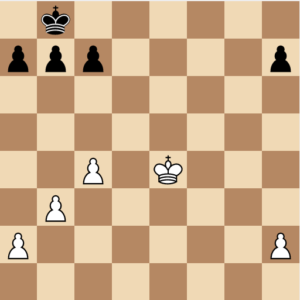
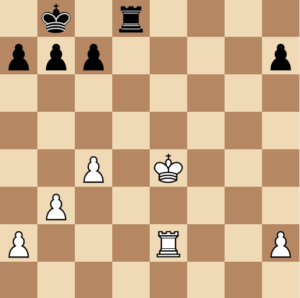
A move that allows your king to come out with tempo, such as F4, are generally best because you’re allowing your king to make his way to the center much quicker than your opponent can if he has a pawn in the way. This assumes both sides have castled king side.
Additionally at this point, most players will keep one or both rooks. If the king is stuck in the back rack with the ideal pawn structure, you can leave yourself open to a backrank mate. Therefore, you will want to make sure your offensive is not distracted by a potential backrank mate.
2. Attempt to Force Zugzwang
When it comes to the endgame sometimes you have to move a piece that you don’t want to. This is known as zugzwang. Zugzwang occurs you force your opponent’s move
When zugzwang occurs, your opponent has done a move that is favorable for you, forcing them to do an unfavorable move.
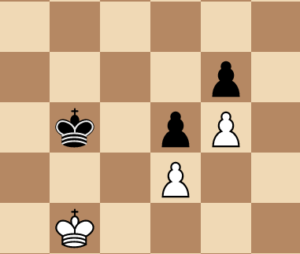
Now if in chess you could skip your turn, you would absolutely do so because all of your pieces are in the right position and none of them want to move out of their positions, but that is not possible. No matter how much you don’t want to, you always have to take your turn. When you’re in a zugzwang’d position, you are forced to do a move that you don’t want to do because you have no other options.
This is why a chess you want to think ahead because if you can force your opponent’s move, you’re always better off. The example below shows zugzwang in action. If White moves you’ll lose a piece and white unfortunately has to move because it’s his turn and all the pieces are where they want to be.
3. Obtain Opposition
Opposition occurs when two kings face each other with one square in between them. At this point, the first king to move, loses. The reason they lose is they are giving up their favorable position and will allow the opponent’s king to get to the square it wants to occupy.
While opposition is an example of Zugswang, I wanted to keep it separate because it is essential to understand. If nothing else, when the time is ticking in your game and you are unsure what to do, try to achieve this diagram
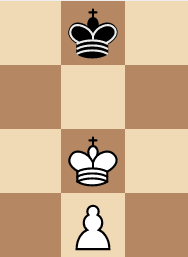
The most common way to get to this position would be with a ton of pawns that are gridlocked. You want to be careful and not move your pawns too hastily. Sometimes you may still have pawns in their original starting position and you should consider whether to move them one or two squares. Because every move counts and you want to take up as many moves as possible to move your opponent’s king out of opposition first, you may choose to push your pawns one square only.
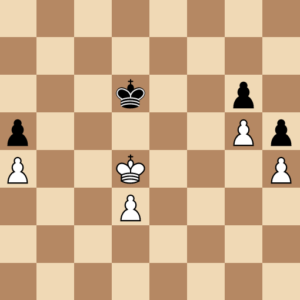
In order to force your opponent into opposition, you may do what is known as a waiting move. Because a king can move one square in any direction, sometimes you don’t want to move directly to the square you want right away. Instead, you will want to move to a square next to it to use up a turn first.
It’s important to bring up distant opposition in which more than one square is between both kings. You will want to apply the same principles and use waiting moves on your journey to the original, one square opposition.
4. Avoid Stalemate When You’re Ahead
Sometimes you’re beating your opponent, but you find you misplay a move and now instead of winning, you have drawn your opponent; this is known as a stalemate.
Stalemate can occur in many different ways. Below are examples of stalemate, all of which occur in the endgame.
- Insufficient mating material – This is when there are no pieces on the board that can checkmate the opponent’s king. An example of this is a a king and knight vs a king.
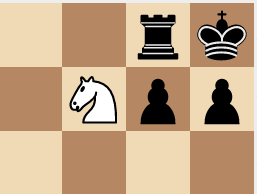
A knight can absolutely checkmate a king by itself in the opening and mid game, but is unable to with only a king remaining on the opponent’s side.
- The king is it not in check and cannot move and there are no other legal moves
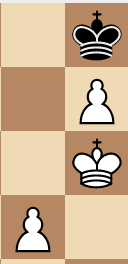
- When both players agree it is a drawn position.
In chess, sometimes you need to be a gentleman and not waste your opponent’s time. If both players know it is a drawn position, and will end up as such, it is proper etiquette to agree to a draw and not let the game hang on any longer. An example of this is rook vs rook, even if pawns exist and no clear advantage is seen.
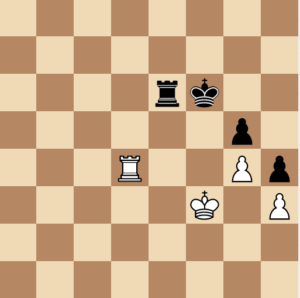
Hoping your opponent will misplay an endgame is not something you see in higher level play. That being said, if you are just starting out, you never know what your opponent knows and I wouldn’t agree to a draw unless you’re absolutely sure it is a drawn position.
When I play chess on chess.com or Lichess.com and my opponent is clearly losing, they may offer a draw in a last ditch effort to gain some points. Be wary of this and understand what a draw actually looks like.
Here are a few examples of drawn positions to consider.

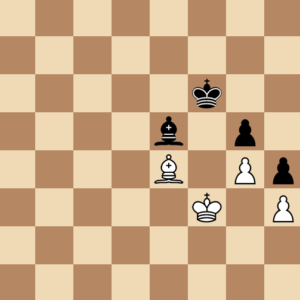
- 50 move rule
This rule of stalemate is especially important for newer players. If you cannot checkmate your opponent and you only have a king, you can start counting to 50 moves. If your opponent cannot checkmate you in 50 moves, then it is a stalemate.
The most common example of this is when you have a king and your opponent has a king, bishop, and knight. Checkmate is possible, but it is the hardest checkmate to do and can take more experienced players a lot of moves to achieve.
Obtaining this checkmate below takes a lot of practice and skill. Many chess teachers will have their students solve for this mate over and over to be able to see the patterns.
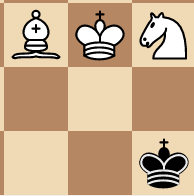
Sometimes newer players end up drawing their opponent when they were clearly winning. The most common example is when they are unsure how to checkmate their opponent. If you are new to chess, check out this guide with a ton of checkmate scenarios. Memorize what these look like so that way you can execute a checkmate as soon as possible over the board.
There are some games you are so far ahead, but then your opponent finds their way into a stalemate. This can be a very big blow and cause you to reflect for quite awhile, especially if that draw ends up taking you out of a top position in a tournament.. Where you could’ve had a full point, you now have a half point, and your rating may fall where it was about to rise before.
5. Create a Passed Pawn
Creating a passed pawn is essential to winning many endgames. Because a big goal of the endgame is to promote your pawn into a queen, or another desired piece, pawns are generally the most important piece in the endgame.
Sometimes being down in material such as an entire rook, will not matter if you have enough passed pawns working together in one pawn island. Sometimes multiple pawn islands of passed pawns can be a game winner.

In this example, there is one rook for your opponent and two pawns for you. Because you have a centralized king and your opponent doesn’t you are definitely in a better position. You may notice that your opponent has five points while you only have two. Based on this position this does not matter at all. Because that rook will end up trading itself for one of those two pawns, your king will be the hero and help march the other pawn into a promoted queen. When this happens, the game is won.
This is why focusing on creating a passed pawn is so powerful. You can create a passed pawn in the mid game and sometimes in the opening. However, it isn’t as important or powerful to create a passed pawn until the endgame because at that point it can be too late for your opponent.
It is also important to note that if you have two passed pawn against a king, in many cases your opponent’s king cannot capture both pawns.
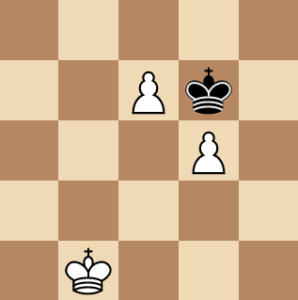
Because of the way pawns protect each other they can can only take one and then the other one is off to the races to the back to become promoted.
6. Get Your Rooks Behind Passed Pawns
In some cases you have created a passed pawn and they are only pawns on the board. However, you may still have other pieces on the board to support that passed pawn and get it to achieve a promotion.
The next piece of advice is to make sure you get your rook or both rooks behind that passed pawn. In some cases you will want the rook in front of the pawn because of some possible surprise checks, such as this scenario. However, if your rook is in front of the pawn, it will have less places to move.
In this example, the rook behind the pawn versus the rook that your opponent has in front of the pawn are in two different scenarios. The rook stuck behind the pawn is preventing the pawn from moving forward, but it can only stay where it is. This makes it tougher for that rook to get into the action of the game since it is stuck.
The other rook, however, is able to move around much more freely while still protecting the pawn. Because it can move around a lot in that file, it is much better off than the rook that cannot move.
7. Exchange When Ahead
This piece of advice occurs at any point of the game, but is most important in the endgame. Because there are less pieces on the board, your opponent will have less chances to checkmate you with less pieces. In fact, the more you trade when you are behind, the less of a chance you have to checkmate your opponent or get a big edge.
When you have a clear edge, start trading pieces. Trading pieces of course means pieces with equal values as this will help you to maintain your edge. If you can trade effectively and you’re already ahead, as long as your position stays strong, you have a much better chance of winning.
Of course sometimes your opponent has tricks up their sleeve and they can regain the piece they lost. As mentioned above, the less pieces that your opponent has, the less opportunity that they have to achieve this goal of evening the position.
Just having that 1 point advantage of a pawn that you achieved in the opening can be enough to win a game. My main goal of the opening always used to be to try to get one pawn. I didn’t worry about getting a knight or bishop via an opening traps (unless I could achieve this) because the opponents I was playing were very good at not letting this happen.
Instead of going for basic traps I knew my opponent would already be ready for, I would set up favorable positions where I would eventually gain a pawn. By focusing my strengths in the opening on getting this pawn, combined with my endgame knowledge, I was a force to be reckoned with. I knew that as long as I could get to the endgame, I would win. This is why studying the endgame, knowing checkmates, and getting a favorable position is so important.
8. Isolate the Opponent’s King
The last piece of advice in general occurs because of rooks. If you can isolate your opponent’s king on one side of the board, you will be able to focus your pieces on the other side of the board.
The best scenario for this is when a rook controls an entire open file, and the king is stuck on one side. You may find your opponent futilely moving their king up-and-down the file, only to have the rook slide all the way to the other side of the file, and the king must begin his journey across the board towards that rock. While the king is wasting moves, your king can begin capturing pawns and helping promote your own pawns. Your opponent’s king is forced to sit and watch.

Another way you can isolate your opponent can be with bishops. In this example below you can see that these parts and bishops achieve the same goal of blocking the Kings moment. You can keep the king from moving towards where he wants to be, you will be in a better position.
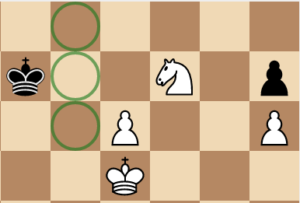
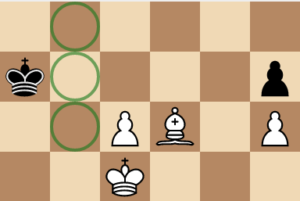
In other cases, you just need to see how to stop the king from moving forward. This can be achieved with multiple pieces helping each other out as in the example below.
I hope you enjoy these endgame principles. These are the principles I’ve always tried to keep in mind in my journey to become a stronger chess player over the years. Please check out these checkmate examples below especially if you’re just starting out. Once you understand these, you’ll avoid draws, understand the goal you were working towards in the endgame, and be a much stronger player. Thanks for reading!
Bonus Checkmate Examples [coming soon]